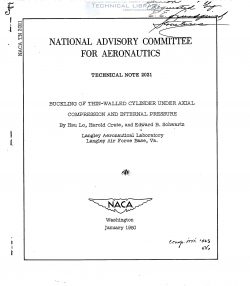naca-tn-2021
- Version
- 182 Downloads
- 795.20 KB File Size
- 1 File Count
- December 13, 2016 Create Date
- December 13, 2016 Last Updated
National Advisory Committee for Aeronautics, Technical Notes - Buckling of Thin Walled Cylinder Under Axial Compression and Internal Pressure

An investigation was made of a thindwalled cylinder under axial
compression and various internal pressures to study the effect of the
internal pressure on the compressive buckling stress of the cylinder.
A theoretical analysis based on.a large—deflection theory was also made.
The theoretically predicted increase of compressive buckling stress
due to internal pressure agrees fairly well with the experimental
results.
The buckling of thin-walled cylinders under axial compression and
lateral pressure has been investigated by Flflgge (reference 1) who
found that the effect of the internal pressure on the buckling load is
negligible. Flflgge's conclusion is in contradiction to the results of
a series of tests, made at the Langley Aeronautical Laboratory of the
NACA, of two curved panels under axial compression and various lateral
pressures.“ The§e_test results, reported in reference 2, showed an
appreciable strengthening effect of the lateral pressure on the buckling
load of the curved panels, The apparent discrepancy between these
experimental results and the prediction by Flflgge‘s theory made it
desirable to investigate this problem further. Consequently, additional
tests were made of a cylinder under axial compression and various
internal pressures for which results are presented herein. A theoretical
analysis of this problem is also presented which differs from that of
Flflgge in that the present analysis is based on large, rather than small,
deflection.theory.
Test—specimen.- The.specimen used for the_ tests_ was a cylinder,
32 inches long with a 15- -inCh inside radius, made of EMS—T aluminum
alloy sheet of O. 02h9~ inch average thickness. It was closely riveted
around two heavy steel rings, one at each end. The butt-Joint of the
two longitudinal edges was covered both inside and outside by straps,
0.032 inch thick and I; inch wide, along the total length of the cylinder.
The two heavy steel rings were made of g- by h-inch steel bar stock
rolled to the diameter of the cylinder. Two %— by 2;inch spreader bars
were used to reinforce the ring as shown in figure 1. A ring with a
flange, machined flat, was fastened to—the %- by h-inch steel ring to
provide an_even bearing surface on which a steel cover plate was fitted.
Three steel blocks were placed on top_of the plate._rThe applied .
compressive load was transmitted from the.machine.haad through the three
steel blocks to the cover plate. The Joint betweenpfihe cylinder and the
cover plates was sealed.
| File | Action |
|---|---|
| naca-tn-2021 Buckling of Thin Walled Cylinder Under Axial Compression and Internal Pressure.pdf | Download |
Comment On This Post